弹塑性力学讲义程序设计1
- 格式:ppt
- 大小:255.00 KB
- 文档页数:29

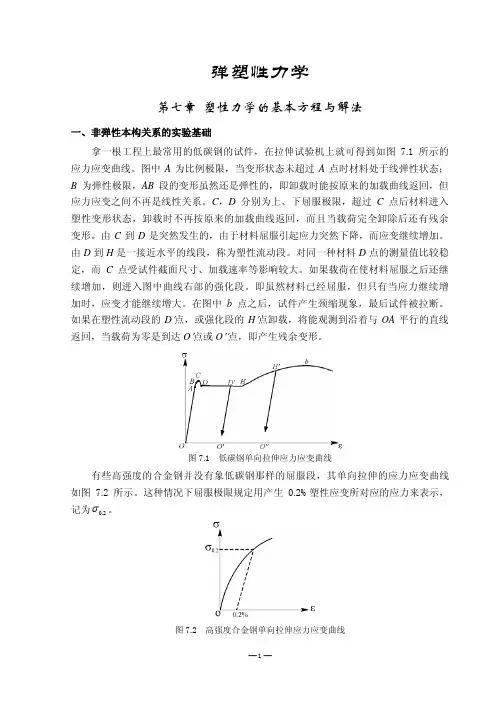
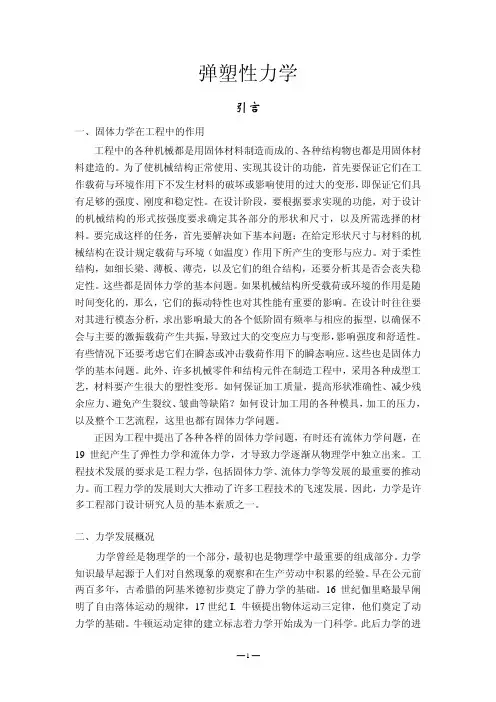
弹塑性力学引言一、固体力学在工程中的作用工程中的各种机械都是用固体材料制造而成的、各种结构物也都是用固体材料建造的。
为了使机械结构正常使用、实现其设计的功能,首先要保证它们在工作载荷与环境作用下不发生材料的破坏或影响使用的过大的变形,即保证它们具有足够的强度、刚度和稳定性。
在设计阶段,要根据要求实现的功能,对于设计的机械结构的形式按强度要求确定其各部分的形状和尺寸,以及所需选择的材料。
要完成这样的任务,首先要解决如下基本问题:在给定形状尺寸与材料的机械结构在设计规定载荷与环境(如温度)作用下所产生的变形与应力。
对于柔性结构,如细长梁、薄板、薄壳,以及它们的组合结构,还要分析其是否会丧失稳定性。
这些都是固体力学的基本问题。
如果机械结构所受载荷或环境的作用是随时间变化的,那么,它们的振动特性也对其性能有重要的影响。
在设计时往往要对其进行模态分析,求出影响最大的各个低阶固有频率与相应的振型,以确保不会与主要的激振载荷产生共振,导致过大的交变应力与变形,影响强度和舒适性。
有些情况下还要考虑它们在瞬态或冲击载荷作用下的瞬态响应。
这些也是固体力学的基本问题。
此外、许多机械零件和结构元件在制造工程中,采用各种成型工艺,材料要产生很大的塑性变形。
如何保证加工质量,提高形状准确性、减少残余应力、避免产生裂纹、皱曲等缺陷?如何设计加工用的各种模具,加工的压力,以及整个工艺流程,这里也都有固体力学问题。
正因为工程中提出了各种各样的固体力学问题,有时还有流体力学问题,在19世纪产生了弹性力学和流体力学,才导致力学逐渐从物理学中独立出来。
工程技术发展的要求是工程力学,包括固体力学、流体力学等发展的最重要的推动力。
而工程力学的发展则大大推动了许多工程技术的飞速发展。
因此,力学是许多工程部门设计研究人员的基本素质之一。
二、力学发展概况力学曾经是物理学的一个部分,最初也是物理学中最重要的组成部分。
力学知识最早起源于人们对自然现象的观察和在生产劳动中积累的经验。

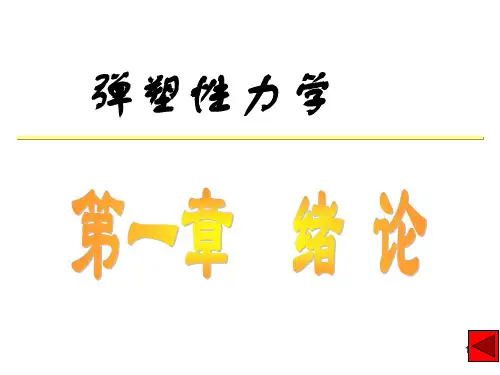

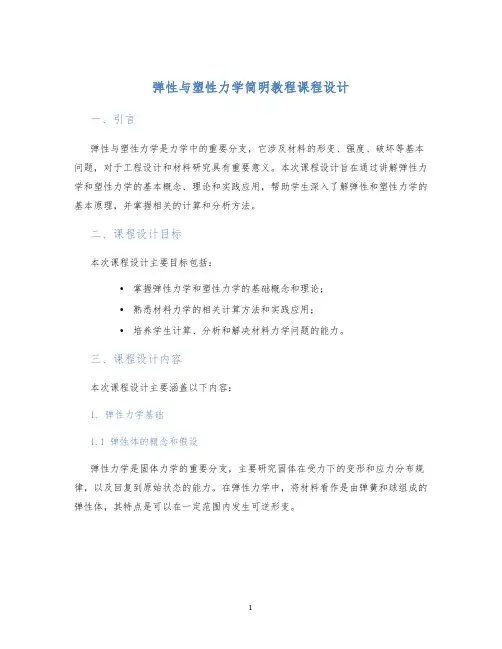
弹性与塑性力学简明教程课程设计一、引言弹性与塑性力学是力学中的重要分支,它涉及材料的形变、强度、破坏等基本问题,对于工程设计和材料研究具有重要意义。
本次课程设计旨在通过讲解弹性力学和塑性力学的基本概念、理论和实践应用,帮助学生深入了解弹性和塑性力学的基本原理,并掌握相关的计算和分析方法。
二、课程设计目标本次课程设计主要目标包括:•掌握弹性力学和塑性力学的基础概念和理论;•熟悉材料力学的相关计算方法和实践应用;•培养学生计算、分析和解决材料力学问题的能力。
三、课程设计内容本次课程设计主要涵盖以下内容:1. 弹性力学基础1.1 弹性体的概念和假设弹性力学是固体力学的重要分支,主要研究固体在受力下的变形和应力分布规律,以及回复到原始状态的能力。
在弹性力学中,将材料看作是由弹簧和球组成的弹性体,其特点是可以在一定范围内发生可逆形变。
1.2 应力、应变及其关系应力是指材料受到的单元面积的力,可以用F/A表示。
在力学中,应力是一个矢量量,其方向与受力面相同。
而应变则是材料在受力下产生的单位变形,通常用$\\Delta L/L$表示。
应力和应变之间的关系可以用杨氏模量、切模量等参数表示。
1.3 弹性本构关系弹性体的变形与应力之间存在一定的函数关系,这种关系称为弹性本构关系。
弹性本构关系通常用弹性模量表示,弹性模量是该材料在弹性阶段的恢复能力大小的参考值。
2. 塑性力学基础2.1 塑性体的概念和假设塑性力学是研究材料在超过一定应力后,出现不可逆形变的行为和过程。
与弹性体不同,塑性体在受力后会出现残余变形,在撤离力后不会完全恢复到原始状态。
塑性体的特性可以用屈服强度、断裂强度等指标来表示。
2.2 塑性体的变形状态和本构关系塑性体的变形状态通常用应力应变曲线来描述,其中塑性变形曲线是非线性的。
而塑性本构关系则是塑性体在不同应力下的变形与应变之间的关系,通常采用背景理论模型来描述。
四、课程设计方法本次课程设计采用课堂讲述和练习相结合的方式,重点讲解材料力学及相关概念和理论,帮助学生识别和计算材料的应力和应变,并进行材料力学的应用练习。
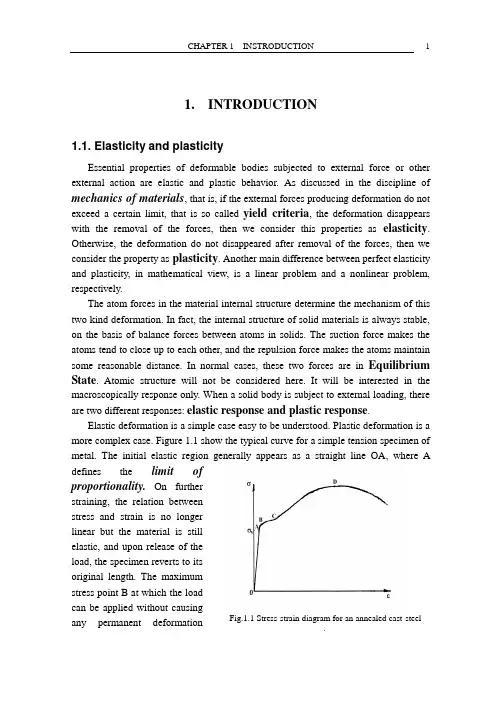
1. INTRODUCTION1.1. Elasticity and plasticityEssential properties of deformable bodies subjected to external force or other external action are elastic and plastic behavior. As discussed in the discipline of mechanics of materials, that is, if the external forces producing deformation do not exceed a certain limit, that is so called yield criteria, the deformation disappears with the removal of the forces, then we consider this properties as elasticity. Otherwise, the deformation do not disappeared after removal of the forces, then we consider the property as plasticity. Another main difference between perfect elasticity and plasticity, in mathematical view, is a linear problem and a nonlinear problem, respectively.The atom forces in the material internal structure determine the mechanism of this two kind deformation. In fact, the internal structure of solid materials is always stable, on the basis of balance forces between atoms in solids. The suction force makes the atoms tend to close up to each other, and the repulsion force makes the atoms maintain some reasonable distance. In normal cases, these two forces are in Equilibrium State. Atomic structure will not be considered here. It will be interested in the macroscopically response only. When a solid body is subject to external loading, there are two different responses: elastic response and plastic response.Elastic deformation is a simple case easy to be understood. Plastic deformation is a more complex case. Figure 1.1 show the typical curve for a simple tension specimen of metal. The initial elastic region generally appears as a straight line OA, where Adefines the limit ofproportionality.On furtherstraining, the relation betweenstress and strain is no longerlinear but the material is stillelastic, and upon release of theload, the specimen reverts to itsoriginal length. The maximumstress point B at which the loadcan be applied without causingany permanent deformation Fig.1.1 Stress-strain diagram for an annealed cast-steelspecimen.(a) (b) (c) (d)Fig. 1.2 Stress-strain diagrams: (a) ductile metal, (b) cast iron and glass, (c) typical concrete or rock,(d) soils, triaxial compression. (Experimental data taken from reference [15].)defines the elastic limit . The point B is also called the yield point , for it marks the initiation of plastic or irreversible deformation. Usually, there is very little difference between the proportional limit, A, and the elastic limit, B. The behavior in the flat region BC is generally referer to as plastic flow . After C the material is exhibited strain hardening or also known as work hardening. Over some point D the material may be exhibit strain softening, as shown in figure 1.1.Now, consider the unloading from some point E beyond the yield point. The behavior is as indicated in figure 1.1. That is, when the stress is reduced, the strain decreases along an almost elastic unloading line OA .So we say that the unloading obey the elastic rule.Fig. 1.2 is the typical graph of stresses versus relative elongation (compression) for four kinds of materials.1.2. Basic hypothesisThe subject of theory of elasticity and plasticity is concerned with the deformation and motion of elastic-plastic bodies or structures under the action of applied load or other disturbances. The general assumptions employed in the study of theory of elasticity and plasticity are the same as those used in the mechanics of continuous medium. Therefore, throughout this book, we have: (a), continuum hypothesis, we shell suppose that the macroscopic behavior of the solid bodies is the same as if they were perfectly continuous in structure; and physical quantities such as the mass and momentum associated with the matter contained within a given small volume will be regarded as being spread uniformly and without any caves, cracks and discontinuous.(b), Uniform hypothesis and isotropic hypothesis, that is, the materials of elastic-plastic body is homogeneous and uniformly distributed over its volume so that the smallest element cut from the body possesses the same specific physical properties as the body. The elastic properties are the same in all directions. (c), small deformation hypothesis, in this book, we discuss small deformation only.1.3. Historical remarksBefore the engineering design of structures, one must not only know the internal force field acting on the structural material and but also know the material response. It means that we need give an analysis of the stresses, deformation and displacement of structural elements. Therefore we have to know the constitutive relation of materials. Seeking some methods to solve these problems, many researchers have continually studied for over 2000 years.The pioneering works of theory of elasticity and plasticity are given by Augustin Cauchy (1789-1857), Marie-Henri Navier (1785-1836), Leonard Euler (1707-1783), Simon Denis Poisson (1781-1840), Barre de Saint-venant (1797-1886), Nikolai Ivanobich Mushihailishibili (1691-1976),Ludwig Prandtl (1875-1858), Thomas Young (1773-1829), Richard von Mises (1883-1953), and many others.The general principles employed in the study of theory of elasticity and plasticity are the same as those used in studying the mechanics of continuous medium. Their basic formulations can be attributed primarily to the work of Euler and Cauchy. Euler first brought forward the general principles of linear and angular momentum balance for continuous media upon which rest all continuum mechanics, including theory elasticity and plasticity. Cauchy first given the concept of the stress and strain at a point and also found the general differential equations of motion or equilibrium of a continuum in term of the stress. Cauchy’s work on elasticity provided a detailedkinematical theory of strain and deformation. The extension of the mathematical theory to more general solids was first made by Navier in 1821 using special assumption concerning the molecular forces of elastic solids. Technical application began earliest in 1855, when Saint-Venant solved the problem of the twisting of prismatic bars and worked out detailed numerical results. Saint-Venant also took up the problem of plastic flow and developed two-dimensional governing equations which were subsequently generalized to three dimensions by M.Levy in 1871. In 1864 H. Tresca reported experiments to the French Academy, which suggested that the plastic yielding of a metal occured when the maximum shear stress reached to a critical value. After Tresca in 1913 R.V on Mises published his yield condition theory based on theory of distortional energy.In the last century (1901-2000) the theory of elasticity and plasticity have rapidly developed in theory and engineering practical. Many great contributors should be mentioned. Such as B.G.Galerkin, G.R.Kirchhoff, S.P.Timoshenko, grange, A.Nadai, A.A.Il’yushin, W.W.Sokolovsky, W.Prager, R.Hill, Kh.A.Rakhmatulin, G.I.Taylor, P.Perzyna, and many others.In this period, especially in last 50 years, theory of elasticity and plasticity rapidly developed in China too. Qian Xueshen, Qian Weichang, Hu Haichang ,Wang Ren, Huang Kezhi, Xu Benye,Wu Jike, Huang zhuping, Gao yuchen, Wang ziqiang, and many others developed the theory of elasticity and plasticity, specially in the engineering applications. In this period published many valuable books about elasticity and plasticity on theoretical and engineering application.。
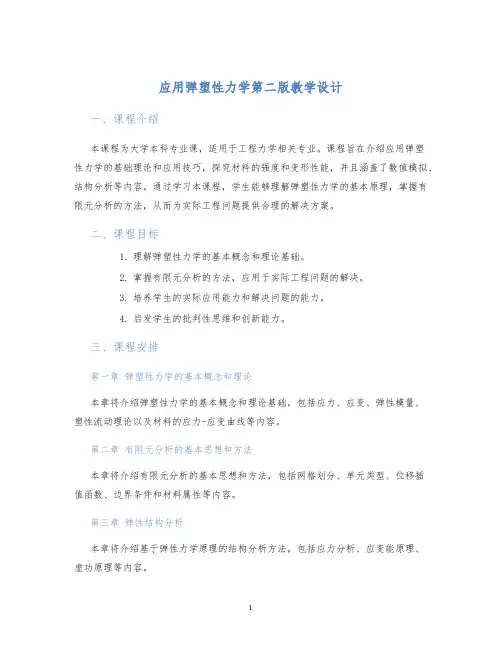
应用弹塑性力学第二版教学设计一、课程介绍本课程为大学本科专业课,适用于工程力学相关专业。
课程旨在介绍应用弹塑性力学的基础理论和应用技巧,探究材料的强度和变形性能,并且涵盖了数值模拟、结构分析等内容。
通过学习本课程,学生能够理解弹塑性力学的基本原理,掌握有限元分析的方法,从而为实际工程问题提供合理的解决方案。
二、课程目标1.理解弹塑性力学的基本概念和理论基础。
2.掌握有限元分析的方法,应用于实际工程问题的解决。
3.培养学生的实际应用能力和解决问题的能力。
4.启发学生的批判性思维和创新能力。
三、课程安排第一章弹塑性力学的基本概念和理论本章将介绍弹塑性力学的基本概念和理论基础,包括应力、应变、弹性模量、塑性流动理论以及材料的应力-应变曲线等内容。
第二章有限元分析的基本思想和方法本章将介绍有限元分析的基本思想和方法,包括网格划分、单元类型、位移插值函数、边界条件和材料属性等内容。
第三章弹性结构分析本章将介绍基于弹性力学原理的结构分析方法,包括应力分析、应变能原理、虚功原理等内容。
第四章弹塑性结构分析本章将介绍基于弹塑性力学原理的结构分析方法,包括受力分析、变形分析、屈曲分析等内容。
第五章有限元分析在结构工程中的应用本章将介绍有限元分析在结构工程中的应用,包括工程应用的实例,在分析过程中的注意事项等内容。
四、教学方法1.讲授法:针对课程理论知识部分,采用讲课的形式。
2.实践教学:针对课程应用和分析部分,采用上机实践教学的形式。
3.课堂讨论:重点讨论难点和疑问,并引导学生批判性思考和创新思维。
五、考核方式1.平时成绩:包括课堂表现、作业、实验报告等。
2.期中考试:占总评成绩的30%。
3.期末考试:占总评成绩的50%。
4.实践考核:占总评成绩的20%。
六、参考教材1.。
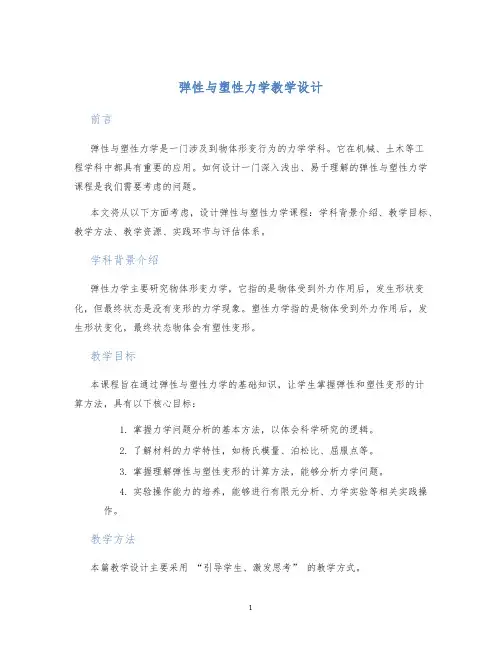
弹性与塑性力学教学设计前言弹性与塑性力学是一门涉及到物体形变行为的力学学科。
它在机械、土木等工程学科中都具有重要的应用。
如何设计一门深入浅出、易于理解的弹性与塑性力学课程是我们需要考虑的问题。
本文将从以下方面考虑,设计弹性与塑性力学课程:学科背景介绍、教学目标、教学方法、教学资源、实践环节与评估体系。
学科背景介绍弹性力学主要研究物体形变力学,它指的是物体受到外力作用后,发生形状变化,但最终状态是没有变形的力学现象。
塑性力学指的是物体受到外力作用后,发生形状变化,最终状态物体会有塑性变形。
教学目标本课程旨在通过弹性与塑性力学的基础知识,让学生掌握弹性和塑性变形的计算方法,具有以下核心目标:1.掌握力学问题分析的基本方法,以体会科学研究的逻辑。
2.了解材料的力学特性,如杨氏模量、泊松比、屈服点等。
3.掌握理解弹性与塑性变形的计算方法,能够分析力学问题。
4.实验操作能力的培养,能够进行有限元分析、力学实验等相关实践操作。
教学方法本篇教学设计主要采用“引导学生、激发思考” 的教学方式。
1.学生自学:课前先让学生通过PPT或者教材阅读等方式自学相关的基础知识,学生自己整理笔记。
2.课堂讲解:教师在课堂上讲解相关的重点、难点问题,并通过例题进行演示,引导学生思考并探究问题。
3.理论演练:通过课后练习或者模拟实验,让学生进行理论练习。
4.实践操作:在教学过程中,安排一些实践操作,如有限元分析、力学实验等。
教学资源1.教师教案:请教师在课前为学生准备详细的教学教案、课件PPT。
2.教学书籍:推荐教师选用李永久的《理论力学课程》或者高华祥的《材料本构理论及其应用》等教学书籍。
3.网络资源:推荐教师让学生通过网络获取更多相关资料,如学术论文、实验视频、技术文献等。
实践环节在本次课程设计中,安排一些实践操作如有限元分析、力学实验等,有助于学生加深对于理论知识的理解,同时能够培养学生的实践操作能力以及实验室管理和实验操作的技能。
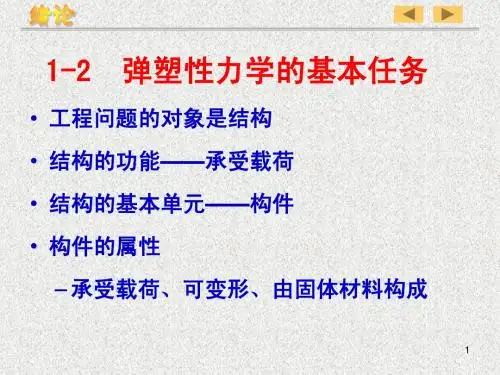
弹塑性力学引论教学设计一、教学目的本门课程是力学中比较重要的一门课,主要内容是弹塑性物体的力学行为及其相关问题。
本门课程旨在培养学生对物理事物的感知能力、分析能力、计算能力以及实际应用能力。
具体来说,本门课程的目的是:1.了解和掌握弹塑性力学的基本理论和知识;2.掌握相关实际应用中弹塑性力学的解决思路与方法;3.能够分析并解决工程实际问题中的弹塑性力学问题。
二、教学内容1.弹性问题:应变、应力、弹性模量、泊松比、弹性平衡方程等;2.材料的塑性本构:理想弹塑性材料、屈服准则、塑性延性、硬化规律和本构方程;3.塑性问题:刚塑性体单轴拉伸和材料本身的塑性极限;4.应用实例:轴对称问题与平面问题。
三、教学方法本门课程采用对基础原理讲解和实际应用实例解析相结合的教学方法。
其中,对基础原理讲解采用理论教学与实例讲解相结合的方式,突出理论教学和实例讲解的结合,在实际应用中体现理论的实用性和指导性,树立理论和实际应用紧密结合的思想。
同时,为了增强学生的学习积极性,本门课程还将采用案例式教学、网上互动等现代教学手段,以提高学生的学习效果。
四、教学步骤教学步骤如下:1.弹性基础:导入弹性问题和弹性平衡方程,讲授应力和应变的概念;2.塑性本构:讲授理想弹塑性材料、屈服准则、塑性延性、硬化规律和本构方程;3.塑性基础:讲解刚塑性体单轴拉伸和材料本身的塑性极限;4.应用扩展:讨论轴对称问题与平面问题的实际应用,并提供解决方案;5.学生互动:收集学生对于本课程的意见和想法,并提供听课笔记以便巩固学习。
五、教学要求1.要求学生掌握弹塑性力学基本理论;2.要求学生了解弹塑性力学在工程实际问题中的应用;3.要求学生能够掌握实际应用中弹塑性力学的解决思路与方法;4.通过理论分析与实例分析,激发学生学习和研究的兴趣。
六、总结本文介绍了弹塑性力学引论教学设计的相关内容,主要是教学目的、内容、方法、步骤、要求等。
通过讲解弹塑性力学的基本理论和相关实际应用,让学生了解和掌握弹塑性力学的基本概念和处理方法,从而培养学生的分析能力和实际应用能力。